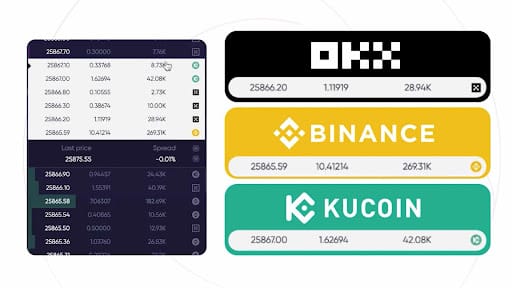Orion’s All-in-One Trading Terminal Aggregates Crypto Liquidity
Disclaimer: The Industry Talk section features insights by crypto industry players and is not a part of the editorial content of Cryptonews.com.

The crypto market today comprises hundreds of centralized exchanges, decentralized exchanges, AMMs, aggregators, and blockchains. Across Layer1s, Layer2s, and even Layer3s, assets such as ETH, USDT, and tokenized BTC can be traded. While this wealth of choice is to be welcomed, the balkanization of crypto trading does bring one major drawback: liquidity fragmentation.
Scattered liquidity provides endless places and ways to trade, but it also means there is finite liquidity to absorb orders. This results in price discrepancies, slippage, and ultimately less money in the trader’s wallet. The cumulative effects of executing hundreds of trades a year on illiquid or suboptimal CEXes and DEXes quickly add up, resulting in thousands of dollars in lost profit – or tens of thousands in the case of whales. Orion is an all-in-one aggregator & trading terminal that was designed to fix this problem.

The Dawn of deCEX
Orion has been hailed as a “deCEX” platform in that it unites CEX and DEX liquidity, providing a trading experience that incorporates the best of both realms. Using Orion, traders can enjoy the benefits inherent to DEXes, namely permissionless access, no custodial risk, and instant access to funds. At the same time, they can take advantage of the attributes more synonymous with CEXes: deeper liquidity, a full order book, and advanced order types.
Orion achieves all this through some clever architecture that routes liquidity from multiple sources, allowing traders to tap into it within a single platform. Not only is this more convenient, in that it obviates having to create multiple exchange accounts or move between multiple DEXes, but it results in better pricing. A combination of lower fees compared to DEXes like Uniswap and lower slippage mean that Orion users can generally expect more bang for their buck. Or to be precise, more tokens for their trade. This, in a nutshell, is the value proposition of the deCEX model.
The Team Behind the Dream
The dream of creating a universal deCEX trading terminal was conceived by Alexey Koloskov and Kal Ali, who founded Orion in 2018. At the time, they recognized that segregated liquidity was becoming a problem, particularly as on-chain trading emerged and the industry entered the multi-chain era. Prior to Orion, Alexey was the chief blockchain architect for Waves, one of the first DEXes, so understood the architecture and the challenges of placing liquidity on-chain.
Since 2018, Orion has evolved gradually into the all-in-one exchange aggregator it is today. There were a few twists and turns along the way, but the launch of Orion Terminal in 2021 marked the protocol’s emergence as a major player in the liquidity aggregation game. Since then, a raft of improvements to the user experience, coupled with the connection of more liquidity sources, have extended Orion’s appeal to traders, particularly as CEXes ramp up KYC and Know Your Transaction (KYT) surveillance, with the natural privacy concerns this brings.
Elsewhere, the recent decision by Uniswap Labs to start imposing a fee for all trades executed on its AMM has strengthened the case for alternative onchain solutions that are demonstrably cheaper. The confluence of these trends – rising CEX surveillance and opaque DEX fees and pricing – has created the optimal conditions for Orion to thrive. It is a concept whose time has come. It is worth mentioning that Orion recently dropped the ‘protocol’ branding from their tagline, with the team hinting that a new brand is soon to emerge from the Orion ecosystem.
Orion in Action
Moving past theory to practical application and how does Orion actually perform? Its terminal has two primary components: a simple interface for quick and easy swaps and an order book that supports more advanced order types. The Swap feature is a good jumping off point for getting a feel for what Orion’s all about. It boasts a clean interface that abstracts complexity while keeping useful features close at hand.
One of the most useful aspects of Swap is its real-time demonstration of the best liquidity source for each token swap. This shows the savings a user will make using Orion versus trading on a standalone DEX or CEX. Because Orion aggregates liquidity, Swap will present the most cost-effective option, be it procured from a CEX, DEX, or Orion pool.
Five EVM chains are currently supported by Orion including Ethereum, Fantom, and Polygon. Alongside the AMM, a chart for the token pair being swapped is displayed, a simple feature that is nevertheless missing from most DEXes. While Swap is great for executing onchain trades, it doesn’t demonstrate Orion’s full capabilities. For this, Trade is where the terminal truly comes into its own.
The Trade page on the Orion Terminal looks just like the order book on a conventional CEX. And from a user perspective, it essentially is, even if in this case there’s no custodial risk or need for account creation. Orion’s deCEX order books provide real-time data, ensuring users have the most up-to-date information to power their trading decisions. Orion’s liquidity nodes tap into CEXes, pulling their order books, and making them available in a decentralized format on Orion. This gives traders access to the vast liquidity of major exchanges without the centralized constraints.
Greater Access, Better Prices
The case for trading on Orion ultimately comes down to two overarching factors: price and access. The ability to tap into liquidity from CEXes and DEXes alike, with no differentiation between the two from a trading perspective, is as convenient as it is cost-efficient. Different CEXes impose different access policies, making it common for traders to be unable to log in to their usual exchange, for example, while on vacation. Orion does away with this by bringing liquidity from tier1 CEXes directly to its terminal.
The other deal-maker for Orion is the lower fees versus trading on a standalone DEX. Orion imposes zero additional fees, allowing traders to access on-chain liquidity at the same price as if they were interacting directly with the native protocol. There’s also just 0.03% charged for stablecoin swaps via CEXes, while other CEX trades on Orion are priced as low as 0.25%.
Orion has done the hard work in creating a user-friendly DEX that delivers on its promise of aggregating very impressive liquidity sources. As the crypto bull market picks up and trading volumes increase, Orion should come of age. With plans for greater cross-chain liquidity aggregation in the works, along with an ambitious referral program, Orion has the potential to become a mainstay of the crypto trading landscape, straddling the worlds of CEX and DEX ultimately striving to provide the best value to all DeFi users.




